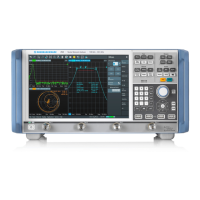Command reference
R&S
®
ZNB/ZNBT
1107User Manual 1173.9163.02 ─ 62
Parameters:
<Boolean> 0 – hide the "Info Window" (default)
1 – show the "Info Window"
Manual operation: See "Info Window" on page 743
DISPlay:LAYout <LayoutMode>
Arranges the diagrams in the screen, leaving the diagram contents unchanged.
Parameters:
<LayoutMode> LINeup | STACk | HORizontal | VERTical | GRID
LINeup – the diagrams are arranged side by side.
STACk – the diagrams are arranged one on top of the other.
HORizontal – the diagrams are arranged in horizontal rows.
VERTical – the diagrams are arranged in vertical rows.
GRID – the diagrams are arranged as a rectangular matrix. The
number of rows and columns is as defined with command
DISPlay:LAYout:GRID.
Example: See DISPlay:LAYout:GRID
Manual operation: See "Split Type" on page 740
DISPlay:LAYout:APPLy <LayoutId>
Selects a previously defined layout for display in the analyzer screen.
Parameters:
<LayoutId> Integer value 1, 2 ...
Current number, as defined by DISPlay:LAYout:DEFine.
Example: See Creating diagrams
Manual operation: See "Additional Functionality: SCPI Commands" on page 740
DISPlay:LAYout:DEFine <LayoutId>, <LayoutFormatMode>, <LayoutData>
DISPlay:LAYout:DEFine? <LayoutId>
Creates a horizontal or vertical display layout and provides it with an identifier (<Layou-
tId>).
Layouts are defined row by row (horizontal layouts) or column by column (vertical lay-
outs).
●
A horizontal layout consists of N rows, each of height h
i
(i = 1 to N). The heights
are defined in units relative to the total height of the screen, i.e. their sum h
1
+ h
2
+ ... h
N
must be equal to 1.00.
Each row contains a selectable number of diagrams with independent widths w
ij
(j
= 1, 2 ...M(i)). The sum of the widths in each row must also match the screen width,
hence w
i1
+ w
i2
+ ... w
iM(i)
= 1.00 for all rows (i = 1 to N).
SCPI command reference

